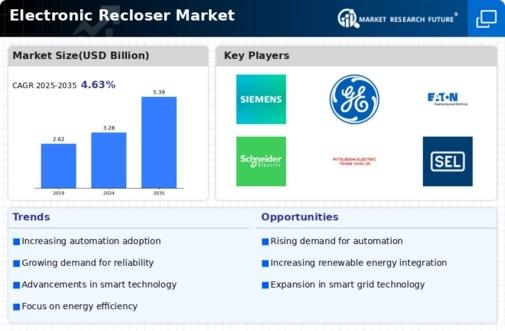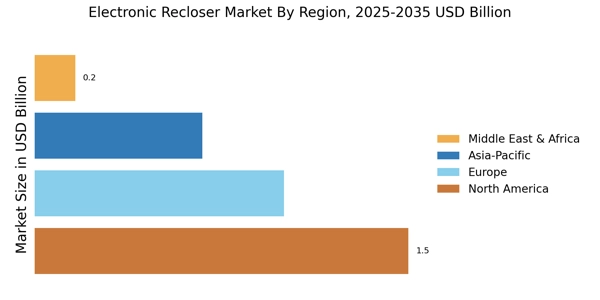Increased Focus on Grid Resilience
The increased focus on grid resilience is a significant driver for the Electronic Recloser Market. As climate change and extreme weather events become more prevalent, utilities are prioritizing the fortification of their electrical grids. Electronic reclosers play a crucial role in enhancing grid resilience by quickly restoring power after outages and minimizing the impact of disturbances. The market is responding to this need, with investments in recloser technologies that can withstand harsh conditions and provide reliable service. Data suggests that utilities are allocating more resources towards upgrading their infrastructure to improve resilience, which is likely to propel the growth of the Electronic Recloser Market in the coming years.
Regulatory Incentives for Modernization
Regulatory incentives for modernization are driving the Electronic Recloser Market forward. Governments and regulatory bodies are increasingly promoting the adoption of advanced technologies in the energy sector to enhance efficiency and reliability. These incentives often include financial support, tax breaks, and grants for utilities that invest in modernizing their infrastructure. As a result, many energy providers are turning to electronic reclosers as a solution to meet regulatory requirements and improve service delivery. The market is likely to benefit from these initiatives, as they encourage the deployment of innovative technologies that align with sustainability goals and enhance grid performance.
Rising Demand for Reliable Power Supply
The increasing demand for a reliable power supply is a primary driver for the Electronic Recloser Market. As urbanization accelerates and populations grow, the need for uninterrupted electricity becomes critical. This demand is further fueled by the expansion of industries and commercial establishments that rely heavily on consistent power. According to recent data, the global electricity consumption is projected to rise significantly, necessitating advanced solutions like electronic reclosers to minimize outages. These devices enhance the reliability of power distribution systems, thereby supporting the growing energy needs of various sectors. Consequently, the Electronic Recloser Market is likely to experience substantial growth as utilities and energy providers invest in modern technologies to ensure a stable power supply.
Growing Integration of Renewable Energy Sources
The growing integration of renewable energy sources is a pivotal driver for the Electronic Recloser Market. As more countries commit to reducing carbon emissions, the shift towards renewable energy is accelerating. This transition necessitates the modernization of electrical grids to accommodate variable energy sources such as solar and wind. Electronic reclosers are essential in managing the complexities associated with integrating these renewables, as they help maintain grid stability and reliability. The market is witnessing an uptick in demand for reclosers that can effectively handle the fluctuations in power supply from renewable sources. This trend indicates a promising future for the Electronic Recloser Market as it aligns with global energy transition goals.
Technological Advancements in Distribution Systems
Technological advancements in distribution systems are reshaping the Electronic Recloser Market. Innovations such as automation, remote monitoring, and data analytics are being integrated into recloser technologies, enhancing their efficiency and functionality. These advancements allow for quicker fault detection and isolation, reducing downtime and improving service reliability. The market is witnessing a shift towards smart reclosers that can communicate with grid management systems, facilitating better decision-making and operational efficiency. As utilities seek to modernize their infrastructure, the adoption of these advanced electronic reclosers is expected to rise, driving growth in the Electronic Recloser Market. The trend indicates a move towards more intelligent and responsive power distribution networks.


















Leave a Comment